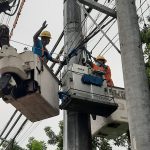Armor Rods
 MATERIALS
MATERIALS
ROD – manufactured from aluminum alloy for use on ACSR, AAC, AAAC and ACAR; from alumoweld for use on alumoweld and from galvanized steel for use on galvanized steel.
OLOR CODE AND CENTER MARK – establishes alignment of rods during application and identifies conductor size.
IDENTIFICATION TAG – identifies catalog number, nominal conductor size, and conductor range.
GENERAL RECOMMENDATIONS
Armor Rods are intended to protect the conductor on which they are being applied against bending and compression stresses, abrasion, and arc-over. The degree of protection needed on a specific line depends upon a number of factors such as line design, temperature, and tension, exposure to wind flow, and vibration history on similar construction in the same area.
Armor Rods should be considered as minimum protection for clamp style supports or bolted suspension arrangements. Armor Rods should be considered as minimum protection for use with hand tied pint type construction of span lengths greater than 300 feet. In urban areas having no experience of vibration, Line Guards may be used in lieu of Armor Rods on spans up to 300 feet maximum.
Armor Rods do not act as vibration dampers. They are designed to provide an extra degree of protection to the conductor at support points. In areas where a history of vibration is known or where vibration is suspected, the use of supplementary Dogbone vibration dampers or Posilok space dampers are recommended
Restorative Repair:
Armor Rods may be used as patch rods to restore full conductance and strength to ACSR, AAAC, AAC, AWAC, ACAR, AW and galvanized steel where damage is located outside the support area and does not exceed 50% of the outer strand layer.
Tapping:
Tapping over applied Armor Rods is permissible with aluminum Armor Rods only, not with steel or alumoweld rods. It is recommended that a non-gritted inhibitor be applied.
Overall Diameter (O.D.) Calculations:
Compute the overall outside diameter as follows:
(Rod Diameter x 2) + Conductor Diameter = Total Applied O.D.
High Voltage Applications:
For 345 kV and above, the rod ends are tapered and designated by adding suffix “E” to catalog number (i.e. AAR2790-E)


 MATERIALS
MATERIALS



